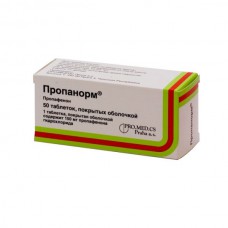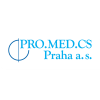Expiration date: 02/2026
Composition and form of issue:
Tablets, film-coated. 1 tablet contains:
propafenone hydrochloride 150 or 300 mg
excipients: MCC granulated starch corn copovidone sodium croscarmellose magnesium sodium stearate lauryl sulfate hypromellose 5 macrogol 6000 titanium dioxide emulsion Dimethicone with silicon dioxide
in the contour cell package 10 PCs. in a pack of cardboard 5 packages.
Description of dosage form:
Round, biconvex tablets, coated with white or almost white.
Pharmacokinetics:
Absorbed more than 95% of the drug. Propafenon exhibits dose-dependent bioavailability, which increases nonlinearly with increasing dose: increases from 5 to 12% with increasing single dose from 150 to 300 mg, and at 450 mg - up to 40-50%. Cmax in plasma after oral intake are achieved within 1-3, 5 h and ranges from 500 to 1500 µg/L. the Permeability of the BBB and placental barrier is low. The volume of distribution of 3-4 l/kg. the Connection with plasma proteins of the blood and internal organs (liver, lungs, etc.) 85-97%.
Therapeutic range the concentration of propafenon in the blood plasma is 0, 5-2, 0 mg/L. Propafenon almost completely metabolized. 11 metabolites of the drug are described-pharmacologically active 5-hydroxypropafenone and N-depropropropafenone, having a comparable to propafenone antiarrhythmic activity. T1/2 "quick metabolization" — 2-10 h, the slow — 10-32 h, biological T1/2 is about 6, 2 h. Excreted: kidneys — 38% as metabolites (less than 1% unchanged), bile — 53% (in the form of glukuronidov and sulphate). With hepatic insufficiency, excretion is reduced.
Description of pharmacological action:
Antiarrhythmic class IC drug blocks the fast sodium channels. Has weak beta-adrenoblokiruta activity and m-holinoblokirutuyu action. Antiarrhythmic effect is based on local anesthetic and direct membrane-stabilizing effect on myocardiocytes, as well as on blockade of beta-adrenoreceptors and calcium channels.
Causes a dose-dependent decrease in the rate of depolarization, depresses phase 0 of the action potential and its amplitude in Purkinje fibers and contractile fibers of the ventricles, inhibits automaticity. Slows the conduction Purkinje fibers. Extends the time of sinoatrial (SA) node and Atria. When using propafenone, the PQ interval is extended and the QRS complex (from 15 to 25) is expanded, as well as the AH and HV intervals. The drug extends the effective refractory period in the Atria, in the AV node, in additional beams and, to a lesser extent, in the ventricles. There are no significant changes in the QT interval. Electrophysiological effects are more pronounced in ischemic than in normal myocardium. It has a negative inotropic effect, which usually appears when the left ventricular ejection fraction is lower than 40%.
The action begins after 1 h after ingestion, reaches a maximum of 2-3 hours and lasts 8-12 hours.
Indications:
- prevention and treatment of supraventricular and ventricular extrasystoles, paroxysmal rhythm disturbances (supraventricular-atrial fibrillation and flutter, WPW-syndrome), atrial-ventricular re-entry tachycardia
- prevention of stable monomorphic ventricular tachycardia.
Contraindications:
- hypersensitivity to the drug components
- digitoxin intoxication
- severe forms of chronic heart failure (decompensation stage), uncontrolled chronic heart failure
- cardiogenic shock (except hypotension due to tachycardia and antiarrhythmic shock)
- severe bradycardia and severe arterial hypotension
- SA blockade, violation vnutriepreserdnaya conducting the blockade of legs of bunch of gisa bifascicular intraventricular blockade AV blockade II–III degree (without pacemaker)
- syndrome of weakness of the sinus node syndrome " tachycardia-bradycardia»
- heart attack
- lactation
- the age of 18 years (efficacy and safety not established).
With caution:
- chronic obstructive pulmonary disease (COPD)
- myasthenia gravis (including myasthenia gravis)
- heart failure (ejection fraction-less than 30%), cardiomyopathy, hypotension, the presence of a permanent or temporary pacemaker
- hepatic cholestasis, hepatic and / or renal insufficiency
- combination with other anti-arrhythmic means, the same effect on the electrophysiology of the heart
- electrolyte disorders (must be corrected before the appointment of propafenone)
- the age of 70 years.
Use during pregnancy and breast-feeding:
The use of propafenone during pregnancy, especially in the I trimester, is possible only when the expected benefit to the mother exceeds the potential risk to the fetus.
Side effect:
From the side of cardiovascular system: bradycardia, AV dissociation, ventricular tachyarrhythmia, angina, worsening of heart failure (patients with reduced left ventricular function), SA blockade, AV blockade, disturbance of intraventricular conduction, and supraventricular tachyarrhythmias, when taken in high doses orthostatic hypotension.
From the digestive system: changes in taste, dry mouth, bitterness in the mouth, nausea, decreased appetite, feeling of heaviness in epigastric, constipation or diarrhea, rarely — liver function, cholestatic jaundice, cholestasis.
From the Central nervous system: headache, dizziness, rarely — blurred vision, diplopia, seizures.
Laboratory parameters: leukopenia, agranulocytosis, increased bleeding time, thrombocytopenia, the appearance of antinuclear antibodies.
From the urogenital system: oligospermia, decreased potency.
Allergic reactions: skin rash, itching, exanthema, skin redness, urticaria, lupus syndrome.
Other: weakness, bronchospasm, hemorrhagic skin rashes.
Drug interaction:
It can not be combined with lidocaine (enhanced cardiodepressive effect).
Increases plasma concentrations of propranolol, metoprolol, digoxin (increases the risk of glycoside intoxication), indirect anticoagulants, cyclosporine. Increases the effect of warfarin (blocks metabolism).
While the use of beta-blockers, tricyclic antidepressants may increase antiarrhythmic action, with local anesthetics-increase the risk of Central nervous system.
Cimetidine and quinidine, slowing metabolism, increase the concentration of propafenone in plasma by 20%, rifampicin-reduces.
Amiodarone increases the risk of development of tachycardia type "pirouette".
Drugs that inhibit SA and AV nodes and have a negative inotropic effect, increase the risk of side effects.
Drugs that inhibit bone marrow hematopoiesis increase the risk of myelosuppression.
Dosage and administration:
Inside, after eating. Tablets should be swallowed whole, with a small amount of water.
The dosage regimen is set individually and adjusted by the doctor.
To stop the paroxysm of atrial fibrillation, a loading dose of 600 mg is used-once orally.
Usually the daily dose is 450 mg (3 times a day for 150 mg every 8 hours). If necessary, increase the dose is made gradually (every 3-4 days) to 600 mg/day for 2 doses or up to a maximum of 900 mg/day for 3 admission.
If the treatment was observed extension of the QRS complex or Qt interval by more than 20% compared to the initial values, or lengthening the PQ interval by more than 50%, extension of the QT interval by more than 500 MS, increase in the frequency and severity of arrhythmia, should reduce the dose or temporarily interrupt the use of Propanorm.
In patients older than 70 years, as well as in patients weighing less than 70 kg, smaller doses are used (the first dose is given in the hospital under the control of ECG and blood PRESSURE).
In violation of liver function (possible cumulation), Propanorm is used in doses of 20-30% of the usual, with impaired renal function (Cl creatinine less than 10%) initial dose — 50% of the original.
Overdose:
Intoxication may occur with a single dose, 2 times the daily symptoms of intoxication appear after 1 hour, maximum-after a few hours.
Symptoms: persistent decrease in blood PRESSURE, nausea, dry mouth, vomiting, midriasis, drowsiness, extrapyramidal disorders, confusion, bradycardia, prolongation of the QT interval, violations of intracardiac and intraventricular conduction, ventricular tachyarrhythmias, paroxysms of polymorphic ventricular tachycardia, SA and AV blockade, asystole, coma, convulsions, delirium, pulmonary edema Oh?
Treatment: gastric lavage, defibrillation, dobutamine, diazepam if necessary-artificial ventilation and indirect heart massage. Hemodialysis is not effective.
Special instruction:
During the course of treatment, especially at the beginning of therapy, ECG monitoring is necessary.
Treatment is recommended to start in a hospital, as the risk of arrhythmogenic action associated with the reception of propafenone is increased. The use of Propanorm should be carried out under the control of the electrolyte balance of the blood (especially the concentration of potassium) and ECG should periodically determine the activity of hepatic transaminases.
In the treatment of ventricular arrhythmias, propafenone is more effective than antiarrhythmic drugs IA and IB classes.
In patients with liver failure, the bioavailability of propafenone increases by 70%, in such patients, it is recommended to reduce the dose and conduct regular monitoring of laboratory parameters.
The indications and dosage especially carefully it is necessary to determine for patients with inserted pacemakers.
Patients undergoing long-term treatment with anticoagulants and hypoglycemic agents should be carefully monitored clinically and in laboratory settings.
If in the course of treatment appear SA block or AV blockade III extent, or repetitive extrasystole, the treatment should be terminated.
Given the possibility of proaritmogennogo exposure, the drug is recommended for use only on prescription and under the supervision of a doctor.
During treatment should refrain from driving vehicles and activities potentially hazardous activities, require high concentration and psychomotor speed reactions.



